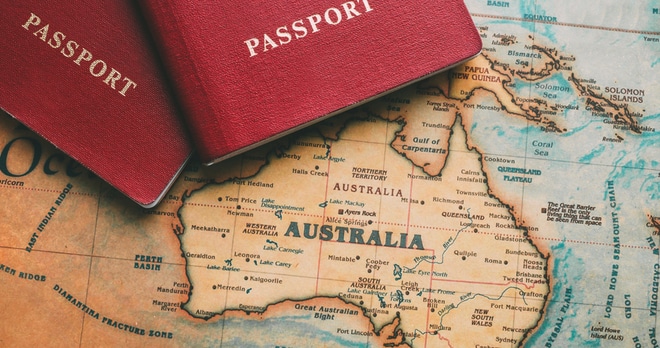Are you considering moving to Australia for work? The land down under has a diverse economy and a high demand for skilled workers in various industries. However, before you can start your dream job, you need to obtain a work permit. Australia’s work permit system can be complex, but it doesn’t have to be overwhelming.
In this piece, we will provide a comprehensive guide to Australia’s work permit system, covering the different types of work permits, eligibility criteria, application process, and more. Read on to discover everything you need to know about working in Australia on a work permit!
Types of Work Permits
Australia offers several types of work permits for foreign workers, each with its own set of requirements and conditions. Below are the most common types of work permits available in Australia:
- Temporary Skill Shortage (TSS) Visa (Subclass 482)
The TSS visa allows skilled workers to work in Australia for up to four years. To be eligible, applicants must have a sponsor and a nominated occupation on the Medium and Long-Term Strategic Skills List (MLTSSL) or Short-Term Skilled Occupation List (STSOL). The TSS visa has three streams: short-term stream, medium-term stream, and labour agreement stream. - Employer Nomination Scheme (ENS) Visa (Subclass 186)
The ENS visa is a permanent work visa that allows skilled workers to work in Australia indefinitely. To be eligible, applicants must have a sponsor and a nominated occupation on the MLTSSL or Regional Occupation List (ROL). Applicants must also meet certain age, skills, and language requirements. - Skilled Independent Visa (Subclass 189)
The Skilled Independent visa is a permanent residency visa that does not require a sponsor or employer nomination. To be eligible, applicants must submit an Expression of Interest (EOI) through the SkillSelect system and meet the points test criteria. Applicants must have a nominated occupation on the MLTSSL or STSOL and meet the minimum points requirement. - Skilled Nominated Visa (Subclass 190)
The Skilled Nominated visa is a permanent residency visa that requires nomination by an Australian state or territory government. To be eligible, applicants must submit an EOI through the SkillSelect system and meet the points test criteria. Applicants must have a nominated occupation on the MLTSSL or STSOL and receive a nomination from a state or territory government. - Working Holiday Visa (Subclass 417)
The Working Holiday visa is a temporary visa that allows young people to work and travel in Australia for up to one year. To be eligible, applicants must be between the ages of 18 and 30 (35 for some countries) and hold a passport from an eligible country.
The requirements and conditions for each type of work permit can vary, so it’s essential to carefully review the eligibility criteria before applying. Some work permits may have additional requirements, such as health and character checks or minimum English language proficiency. It’s also essential to note that work permits may have restrictions on the type of work that can be performed, the duration of employment, and the ability to bring dependents.
Eligibility Criteria for Obtaining a Work Permit
To obtain a work permit in Australia, applicants must meet certain eligibility criteria, which can vary depending on the type of work permit. Below are some general eligibility requirements that applicants must meet:
- Educational Qualifications:
Most work permits require applicants to have a certain level of educational qualifications, such as a diploma, degree, or trade certificate. The type of qualification required will depend on the occupation and the type of work permit. - Work Experience:
Many work permits require applicants to have work experience in their nominated occupation. The amount of work experience required will depend on the type of work permit and the occupation. - Language Proficiency:
Applicants may be required to demonstrate proficiency in English by taking an approved language test, such as the International English Language Testing System (IELTS) or the Occupational English Test (OET). - Age:
Some work permits have age requirements, and applicants must be within a certain age range to be eligible. For example, the Working Holiday visa is available to applicants between the ages of 18 and 30 (35 for some countries). - Health:
Applicants must meet certain health requirements to be granted a work permit in Australia. This may include undergoing a medical examination and providing evidence of good health. - Character:
Applicants must meet character requirements, which include providing police clearance certificates from all countries they have lived in for more than 12 months in the last 10 years. Applicants with a criminal record or who have been associated with criminal organizations may not be granted a work permit.
It’s essential to carefully review the eligibility criteria for the specific type of work permit before applying. In addition to the above requirements, some work permits may have additional requirements, such as minimum income or sponsorship by an employer. By meeting the eligibility criteria, applicants can increase their chances of obtaining a work permit in Australia.
Application Process
Applying for a work permit in Australia involves several steps. Here’s a step-by-step guide on how to apply for a work permit in Australia:
Step 1: Determine the Type of Work Permit
The first step in the application process is to determine the type of work permit you are eligible for. This will depend on your occupation, qualifications, work experience, and other factors.
Step 2: Submit an Expression of Interest (EOI)
For some work permits, such as the Skilled Independent Visa and Skilled Nominated Visa, you will need to submit an Expression of Interest (EOI) through the SkillSelect system. This will allow you to express your interest in applying for a work permit and will be used to determine your eligibility.
Step 3: Obtain a Sponsor or Employer Nomination (if Required)
For some work permits, such as the Temporary Skill Shortage Visa and the Employer Nomination Scheme Visa, you will need to have a sponsor or employer nomination before applying.
Step 4: Gather Required Documents
To apply for a work permit in Australia, you will need to provide various documents, including your passport, proof of qualifications, proof of work experience, and language proficiency test results. The specific documents required will depend on the type of work permit.
Step 5: Submit Your Application
Once you have all the necessary documents, you can submit your application online through the Department of Home Affairs website. You will need to pay the application fee at this time.
Step 6: Wait for a Decision
After you have submitted your application, you will need to wait for a decision from the Department of Home Affairs. The processing time can vary depending on the type of work permit and the volume of applications.
Step 7: Receive Your Work Permit
If your application is successful, you will receive your work permit. You can then use this to enter Australia and begin working.
The application fees for work permits in Australia can vary depending on the type of permit and whether you are applying from inside or outside of Australia. As of 2023, the fees for some common work permits are as follows:
- Temporary Skill Shortage Visa (Subclass 482): $1,265 AUD for the short-term stream and $2,645 AUD for the medium-term stream.
- Employer Nomination Scheme Visa (Subclass 186): $4,045 AUD for the nomination and $4,045 AUD for the visa application.
- Skilled Independent Visa (Subclass 189): $4,045 AUD for the main applicant.
- Skilled Nominated Visa (Subclass 190): $4,045 AUD for the main applicant.
It’s important to note that these fees are subject to change, so it’s essential to check the Department of Home Affairs website for the most up-to-date information.
Recommended Post:
- Can International Students Work In Australia?
- Pros And Cons Of Short Term Loans
- Best Health Insurance In USA
In conclusion, obtaining a work permit in Australia can be a complex process, but it can also lead to many opportunities for personal and professional growth. By understanding the different types of work permits available, the eligibility criteria, and the application process, you can increase your chances of success.
Remember that the key to a successful application is preparation. Make sure you have all the required documents, meet the eligibility criteria, and have a solid understanding of the work permit you are applying for. With the right preparation, patience, and determination, you can successfully obtain a work permit in Australia and begin your new career journey. So don’t be afraid to take that first step and explore the possibilities that await you in Australia!






